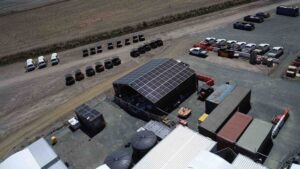Anglo-Australian mining colossus Rio Tinto will trial a new solar thermal technology backed by Microsoft founder Bill Gates at one of its mines in California, as it pushes to reduce its emissions 15 per cent over the next decade.
The technology, developed by Californian start-up Heliogen, uses mirrors and a tower receiver to heat molten salt, which is then used to create steam to power a turbine.
Unlike solar photovoltaic technology, solar thermal – also known as concentrated solar power (CSP) – can store the energy from the sun in the molten salt for use at night or on cloudy days.
Heliogen says its technology is better than other CSP methods because it has managed to concentrate solar energy to exceed temperatures of more than 1,000 degrees celsius, which it calls a “singular scientific achievement”.
“At that temperature, Heliogen can replace the use of fossil fuels in critical industrial processes, including the production of cement, steel, and petrochemicals, dramatically reducing greenhouse gas emissions from these activities,” the company says.
CSP remains a niche technology, with around 7 gigawatts of projects worldwide, or around 1 per cent of the world’s total solar capacity. Despite being dwarfed by cheap solar PV, CSP technology continues to evolve. Australian CSP company Vast Solar this week announced it was a step closer to building its own 50 MW solar thermal hybrid plant in Mount Isa. Chief executive Craig Wood believes the technology is ideal for hot, isolated sites like mines.
Rio Tinto’s initial trial of Heliogen’s technology will have a negligible effect on the company’s emissions. At the moment, the borates mine in question is powered entirely by gas and this would largely continue, with the CSP only cutting emissions by 7 per cent.
However, Rio Tinto says it will consider scaling up the CSP facility so it reduces emissions by 24 per cent. It could then be rolled out on a larger scale, and make more of a dent on the company’s enormous carbon emissions, which total more than 550 million tonnes a year across scopes 1, 2 and 3 – more than Australia’s total annual emissions.
Rio Tinto plans to reduce its scope 1 and 2 (direct and electricity usage) emissions by 15 per cent on 2018 levels by 2030. It says this target is in step with the Intergovernmental Panel on Climate Change’s recommended 45 per cent cut on 2005 levels by 2030, because it has already cut its emissions by 30 per cent from that baseline.
That target, though, does not include the scope 3 emissions that are created when Rio Tinto’s customers smelt its iron ore to make steel. Scope 3 is by far the biggest contributor to Rio Tinto’s emissions, accounting for a staggering 519 million tonnes of carbon dioxide equivalent a year. That’s almost almost 16 times its scope 1 and 2 emissions, which are 31.5 million tonnes a year.
Rio Tinto says it is addressing scope 3 emissions by helping customers find low carbon alternatives to coking coal in the steelmaking process – the most promising of which is renewable hydrogen.
Rio Tinto chief executive Jakob Stausholm said the deal with Heliogen had “the potential to significantly reduce our emissions at Boron by using this groundbreaking solar technology, and we look forward to exploring opportunities across our global portfolio”.
“Addressing climate change effectively will require businesses, governments and society to work together through partnerships like this one, to explore innovative new solutions throughout the entire value chain.
“Our work with Heliogen is part of Rio Tinto’s commitment to spend approximately $1 billion on emissions reduction initiatives through to 2025 and our commitment to work with world-leading technology providers to achieve this goal.”









